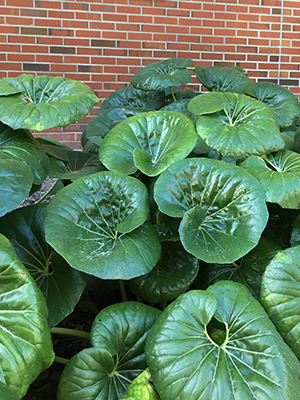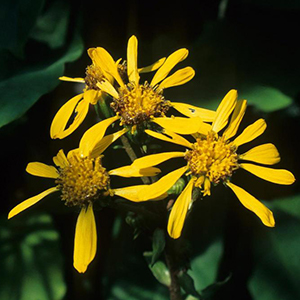Farfugium

This farfugium plant is thriving on the UF campus. UF/IFAS.
It’s not often you find a wow-worthy plant that thrives in shade and blooms, but farfugium checks those boxes. When fall arrives, farfugium really begins to shine. It sends up clusters of yellow flowers that hover over its glossy foliage making for a very interesting combination of daisy-like blooms and tropical leaves. The large, dark green, leaves themselves are interesting year-round and can transform a shaded area into a lush oasis.
Characteristics
Farfugium japonicum is native to Japan and grows in zones 7–10 in the United States. Farfugium is also called leopard plant, a name it gets from the spotted yellow or white patterns found on the leaves of some cultivars. Solid green, variegated, and crinkled leaf forms also exist. The often lily pad-shaped leaves have a leathery, tropical look that is truly eye-catching. For something a little larger, F. japonicum var. giganteum produces leaves that can reach 15 inches across. Mature farfugium plants vary in height reaching up to two feet tall. These plants are cold hardy making them great for all parts of Florida.
Some farfugium cultivars include ‘Aureomaculatum’ (yellow spots on green leaves), ‘Argenteum’ (white markings on green leaves), ‘Kinkan’ (yellow edged green leaves), ‘Crispatum’ (leaves are curled like lettuce and come in various shades of green), ‘Shishi Botan’ (interestingly shaped crinkled leaves provide texture), ‘Kagami Jishi’ (green frilly leaves with spots of yellow), and ‘Tsuwabuki’ which has green leaves.
Planting and Care
Farfugium does best when planted in partial shade and irrigated. Keep in mind that these plants really stand out when you have a mass planting; farfugium is so fantastic you can’t have just one. This spreading perennial grows in clumps that can be divided in spring, making it a great plant to pass along to other garden lovers. It is also well-adapted to containers.

Farfugium flowers. Photo: John Ruter, University of Georgia, Bugwood.org.
UF/IFAS Publications
- Annual and Perennial Gardening Lab Presentation (PDF; includes many photos of farfugium cultivars)

